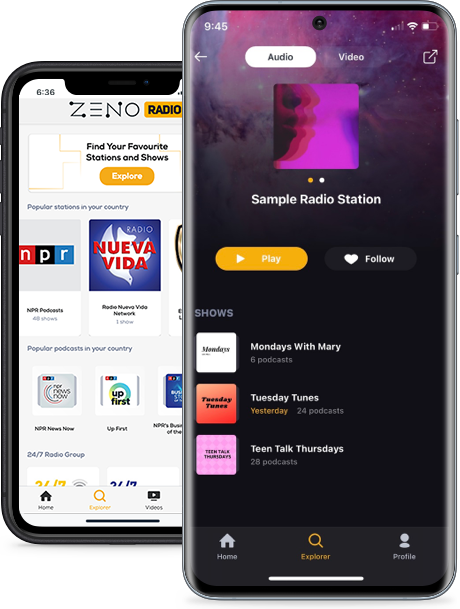In this fast-changing world, the need to transmit critical information promptly is crucial. On how to activate eas on zeno.fm, for a radio show host, turning on the Emergency Alert System (EAS) can make a big difference when it comes to keeping your audience informed during emergencies. Weather advisories or safety notices, having a consistent alarm system ensures that you are always in touch with your listeners at critical times.
But where do you start? The task may appear intimidating initially, but fret not! With only three essential steps, you will have your EAS up and running in no time. This post will discuss how to activate eas on zeno.fm and prepare yourself for any emergency.
Understanding EAS on zeno.fm

The Zeno. An emergency alert system (EAS) is purposely created to supply timely information in disaster situations. It permits broadcasters to quickly send out the most important developments, thereby ensuring that their listeners receive updates in a timely manner.
Fast communication can save lives today. EAS works hand in hand with your broadcasting platform, immediately reaching out to as many people as possible. This facility is good for your station’s reliability and credibility if these fall into place, whether it’s severe weather warnings or public safety announcements.
They understand how EAS works on Zeno. Fm is vital for its practical implementation purposes. You should be ready for crises to act fast in case they happen. Your leverage for this tool now makes you a trusted information provider within your community, thus strengthening bonds with the audience and putting their welfare first and foremost.
Step 1: Setting Up Your Emergency Alert System
To communicate effectively during emergencies, you must set up your Emergency Alert System (EAS) on Zeno. fm. You can start by logging into your Zeno—FM account. If you don’t have one yet, you can create one; it is simple.
The next step is to go to the EAS Settings. This part of the website has options specific to emergency alerts. Before we move on to other things, let’s get a bit acquainted with these features; they help to organize the alert process.
Make sure that all the contact details are accurate and up to date. This will ensure timely notifications without any delays.
It would be advisable to choose various channels for notification purposes. Email, text messages, or even social media sites could be some of these platforms. The more means of receiving alerts you offer, the more equipped your listeners will be in crisis situations.
Step 2: Creating and Testing Your Emergency Alerts
It would help if you created emergency alerts. Start by composing messages that are clear and to the point; remember, urgency should be well conveyed. Use simple language that all can understand.
After writing down your alerts, it is time for testing. This step ensures that your message is not only compatible but also tested across all platforms without any hitches. Zeno-fm test features may be used to create a real alert scenario that will simulate this kind of situation.
Seek inputs from colleagues or friends who could give insights concerning clarity as well as the tone. Adjusting the wording based on their replies may be necessary.
You should try running a fake drill to determine how quickly the alert goes up with listeners. Timing matters most during emergencies; therefore, efficiency must be ensured through both delivery and comprehension.
This practice not only helps you refine content but also builds confidence in using the system in critical situations like these.
Step 3: Broadcasting Your Emergency Alerts
After your notification is designed and tested, the next step is to effectively send it. This stage is important because it ensures that recipients receive news at the right time.
Choose appropriate media for broadcasting. Use Zeno. FM can be linked with different broadcasting services to reach a wider audience. Make your alert available in all communication channels.
Timing is vital in emergency cases. When circumstances have been confirmed, activate your alerts instantly. Quick distribution saves lives and also lets communities know.
As you broadcast, monitor for feedback from listeners. Engagement can help determine whether the message has been well received or if further clarification is needed.
Updates should be sent as things change. Remember this point: Informing people of updates creates trust and shows support during hardship times.
Tips for a Successful EAS Implementation
Clear communication is critical to the successful implementation of EAS. In case of an emergency, make sure your team members understand what they are supposed to do.
Regular training can make a huge difference. Equip everyone with knowledge about the EAS system so that they can confidently act during emergency situations.
Make a detailed plan for disseminating alerts. This plan guides streamlining critical situation processes.
Keep up-to-date contact lists for local authorities and emergency services. These contacts should be easily accessible to facilitate prompt responses when necessary.
Test, test, test – carry out regular drills to identify any weaknesses or gaps in your process. This action prepares your team and also ensures trust among your community regarding alert effectiveness.
Gather feedback after every drill or actual incident. Consistent improvement keeps EAS relevant and efficient while it responds to new challenges as they emerge.
Common Mistakes to Avoid
While activating EAS on Zeno. Fm, it is essential to avoid the usual pitfalls. The first of these is to remember to update your contact list regularly. This list should include all the appropriate staff members and their contacts.
Another common mistake is not regularly testing alerts. This step should never be omitted to avoid confusion during an emergency. Regular tests ensure that everyone understands how to proceed and that the technology works properly.
Be aware of message clarity in any way. Unclear or complicated expressions can cause confusion, which will make your listeners take more time to understand vital information.
Refrain from assuming that everyone knows EAS operations. Offering training sessions will ensure that all concerned individuals are conversant with how the system functions and its protocols.
Conclusion
To alert your listeners to any emergency situation, activate the Emergency Alert System on Zeno.fm. These actions are important for understanding EAS’s mode of operation, configuring your system correctly, and providing effective alerts to the public in general, which will help keep your community informed.
Remember to test your alerts regularly and follow best practices for implementation. Avoid common pitfalls like neglecting to update alert information or failing to engage with listeners before an emergency occurs. With careful planning and execution, you will be well-prepared to activate EAS on zeno.fm when it matters most. Stay proactive, stay connected, and ensure that you’re ready when the need arises.
FAQs:
Q: How do I start learning how to activate EAS on zeno.fm?
A: Begin by logging into your Zeno.fm account and navigating to the EAS Settings section.
Q: What is the first step in the process of how to activate EAS on zeno.fm?
A: The first step is to log into your Zeno.fm account and access the EAS Settings.
Q: How can I ensure that my alerts are effective when I learn how to activate EAS on zeno.fm?
A: Make sure to test your alerts thoroughly across all platforms before broadcasting them.
Q: What should I do if I need to update my contact list for EAS on zeno.fm?
A: Regularly update your contact details in the EAS Settings to ensure timely notifications.
Q: How can I test my EAS alerts on zeno.fm effectively?
A: Use Zeno. fm’s test features to simulate emergency alerts and gather feedback on clarity and timing.
Q: Why is it essential to test alerts when learning how to activate EAS on zeno.fm?
A: Testing ensures that alerts are clear, timely, and correctly received by all intended channels.
